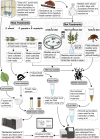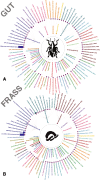Inside the Belly of the Beast: Exploring the Gut Bacterial Diversity of Gonipterus sp. n. 2
- PMID: 40220189
- PMCID: PMC11993490
- DOI: 10.1007/s00248-025-02524-1
Inside the Belly of the Beast: Exploring the Gut Bacterial Diversity of Gonipterus sp. n. 2
Abstract
The Eucalyptus snout beetle (Gonipterus sp. n. 2) is a destructive invasive pest of Eucalyptus plantations, responsible for significant defoliation and wood yield losses globally. Native to Australia, this beetle has adapted to thrive on diverse Eucalyptus hosts, overcoming their chemical defences. However, the mechanisms by which Gonipterus tolerates or utilises these plant defence metabolites remain poorly understood. In South Africa, Gonipterus sp. n. 2 poses a significant threat to Eucalyptus plantations by causing extensive defoliation and leading to substantial reductions in growth and wood production. This study investigates the relationship between diet, host Eucalyptus species, and the gut microbiome of Gonipterus sp. n. 2. Using controlled feeding experiments, beetles were reared on artificial, semi-artificial, and natural diets, as well as two Eucalyptus genotypes with distinct secondary metabolite profiles. High-throughput 16S rDNA sequencing and gas chromatography-mass spectrometry (GC-MS) revealed significant shifts in gut bacterial diversity and composition across diets. Natural diets supported the most diverse microbial communities, while artificial diets fostered a homogenised microbiome dominated by opportunistic taxa like Serratia. Host-specific effects were observed in frass microbiota, with substantial biotransformation of monoterpenes into less toxic derivatives. The results highlight the plasticity of Gonipterus gut microbiota, which enables metabolic adaptability and resilience in diverse environments. This microbial flexibility underpins the invasiveness of Gonipterus, emphasising the role of gut symbionts in overcoming host chemical defences. Understanding these interactions offers novel insights for microbiome-targeted pest management strategies, providing a sustainable approach to mitigate the impact of Gonipterus on global Eucalyptus forestry.
Keywords: Eucalyptus snout beetle; Insect-microbe interactions; Invasive pests; Microbiome; Plant metabolites.
© 2025. The Author(s).
Conflict of interest statement
Declarations. Competing interests: The authors declare no competing interests.
Figures





Similar articles
-
Susceptibility of Eucalyptus trees to defoliation by the Eucalyptus snout beetle, Gonipterus sp. n. 2, is enhanced by high foliar contents of 1,8-cineole, oxalic acid and sucrose and low contents of palmitic and shikimic acid.Plant Cell Environ. 2023 Nov;46(11):3481-3500. doi: 10.1111/pce.14696. Epub 2023 Aug 17. Plant Cell Environ. 2023. PMID: 37592766
-
First record of a new microsporidium pathogenic to Gonipterus platensis in Brazil.Sci Rep. 2021 May 26;11(1):10971. doi: 10.1038/s41598-021-90041-9. Sci Rep. 2021. PMID: 34040020 Free PMC article.
-
Entomopathogenic fungi as the microbial frontline against the alien Eucalyptus pest Gonipterus platensis in Brazil.Sci Rep. 2021 Mar 31;11(1):7233. doi: 10.1038/s41598-021-86638-9. Sci Rep. 2021. PMID: 33790337 Free PMC article.
-
Does Host Plant Drive Variation in Microbial Gut Communities in a Recently Shifted Pest?Microb Ecol. 2023 Jul;86(1):636-646. doi: 10.1007/s00248-022-02100-x. Epub 2022 Aug 23. Microb Ecol. 2023. PMID: 35997797
-
Invasive indoor pests under the microbiological lens: bacterial and viral diversity from local to global scales in bed bugs and cockroaches.Curr Opin Insect Sci. 2025 Jun;69:101344. doi: 10.1016/j.cois.2025.101344. Epub 2025 Feb 8. Curr Opin Insect Sci. 2025. PMID: 39929276 Review.
References
-
- Mapondera TS, Burgess T, Matsuki M, Oberprieler RG (2012) Identification and molecular phylogenetics of the cryptic species of the Gonipterus scutellatus complex (Coleoptera: Curculionidae: Gonipterini). Aust J Entomol 51:175–188. 10.1111/j.1440-6055.2011.00853.x
-
- Schröder ML, Slippers B, Wingfield MJ, Hurley BP (2020) Invasion history and management of Eucalyptus snout beetles in the Gonipterus scutellatus species complex. J Pest Sci 93:11–25. 10.1007/s10340-019-01156-y
-
- Reis AR, Ferreira L, Tomé M, Araujo C, Branco M (2012) Efficiency of biological control of Gonipterus platensis (Coleoptera: Curculionidae) by Anaphes nitens (Hymenoptera: Mymaridae) in cold areas of the Iberian Peninsula: Implications for defoliation and wood production in Eucalyptus globulus. For Ecol Manage 270:216–222. 10.1016/j.foreco.2012.01.038
-
- Cooper PD (2001) What physiological processes permit insects to eat Eucalyptus leaves? Austral Ecol 26:556–562. 10.1046/j.1442-9993.2001.01142.x
-
- Salehi B, Sharifi-Rad J, Quispe C, Llaique H, Villalobos M, Smeriglio A, Trombetta D, Ezzat SM, Salem MA, Zayed A (2019) Insights into Eucalyptus genus chemical constituents, biological activities and health-promoting effects. Trends Food Sci Technol 91:609–624. 10.1016/j.tifs.2019.08.003
MeSH terms
Substances
LinkOut - more resources
Full Text Sources
Miscellaneous

